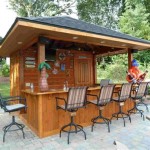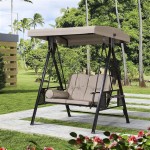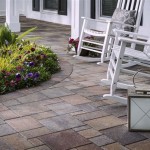Enhance Your Outdoor Living Space With Patio Stair Railings Design
Patio stair railings serve a multi-faceted purpose in outdoor living spaces. Beyond their primary function of ensuring safety, they significantly contribute to the aesthetic appeal and overall design of the area. Careful consideration of materials, styles, and local building codes is essential to achieving both functionality and visual harmony.
A well-designed patio stair railing integrates seamlessly with the existing landscape and architectural style of the home. It can transform a simple utilitarian structure into a focal point, adding character and value to the property. Conversely, a poorly chosen railing can detract from the overall aesthetic, compromising the space's visual coherence. This article explores various aspects of patio stair railing design, offering insights into materials, styles, and important considerations for homeowners.
Material Selection for Patio Stair Railings
The choice of material for patio stair railings is a crucial decision that impacts both the appearance and longevity of the structure. Several options are available, each with its own advantages and disadvantages.
Wood remains a popular choice due to its natural beauty and versatility. It can be stained or painted to match any color scheme and offers a warm, inviting aesthetic. However, wood requires regular maintenance, including sealing, staining, or painting, to protect it from the elements and prevent rot, insect infestation, and warping. Pressure-treated lumber is a common option for outdoor applications, offering increased resistance to decay. Hardwoods like cedar and redwood are naturally durable and require less maintenance than softer wood types, but they also come at a higher cost.
Metal railings, such as those made from wrought iron, aluminum, or stainless steel, provide a durable and low-maintenance alternative to wood. Wrought iron offers a classic, elegant look and can be custom-designed with intricate patterns. However, it is prone to rust and requires regular painting or powder coating for protection. Aluminum is a lightweight and corrosion-resistant option, making it suitable for coastal environments. It can be powder-coated in a variety of colors and is relatively easy to install. Stainless steel is the most durable and corrosion-resistant metal option, but it is also the most expensive. It offers a sleek, modern aesthetic and requires minimal maintenance.
Composite railing materials, typically made from a blend of wood fibers and plastic, offer the look of wood without the maintenance requirements. These materials are resistant to rot, insects, and fading, making them a long-lasting option for outdoor use. Composite railings are available in a variety of colors and styles, and they can be easily installed using standard woodworking tools. While generally more expensive than wood initially, the reduced maintenance costs make them a cost-effective choice in the long run.
Glass railings offer a contemporary and unobstructed view, making them ideal for patios with scenic surroundings. Tempered glass is used for safety and is typically combined with metal posts and frames. Glass railings are easy to clean and require minimal maintenance, but they can be more expensive than other railing options. They are also susceptible to scratches and may require replacement if damaged.
Styles and Designs of Patio Stair Railings
Beyond material selection, the style and design of patio stair railings play a significant role in defining the aesthetic of the outdoor space. The chosen style should complement the architectural style of the home and reflect the homeowner's personal taste.
Traditional railing designs often feature ornate details, such as decorative posts, balusters, and handrails. Wrought iron railings with intricate scrollwork are a classic example of traditional style. Wood railings with turned balusters and decorative post caps also fall into this category. Traditional designs evoke a sense of timeless elegance and craftsmanship.
Contemporary railing designs emphasize clean lines, minimalist aesthetics, and modern materials. Stainless steel railings with simple, linear designs are a popular choice for contemporary homes. Glass railings with minimal framing are another option that provides a sleek and modern look. Contemporary designs often incorporate unique features, such as cable railings or horizontal bars, to create a visually striking effect.
Rustic railing designs incorporate natural materials and rugged textures to create a warm and inviting atmosphere. Wood railings made from rough-hewn lumber or reclaimed wood are common in rustic settings. Metal railings with a weathered finish or hammered texture can also contribute to a rustic aesthetic. These designs often incorporate elements inspired by nature, such as branches or stones.
Coastal railing designs typically utilize materials and colors that evoke the feeling of the beach. White or light-colored railings are common, as are materials that are resistant to salt air and moisture. Cable railings are a popular choice for coastal homes, as they provide unobstructed views of the ocean. Coastal designs often incorporate nautical elements, such as rope or anchor motifs.
Custom railing designs offer the opportunity to create a truly unique and personalized outdoor space. Homeowners can work with designers or fabricators to create railings that incorporate specific design elements, materials, and colors. Custom designs can be tailored to fit the specific architectural style of the home and reflect the homeowner's personal tastes.
Key Considerations for Patio Stair Railing Installation
Proper installation is critical to the safety and longevity of patio stair railings. It is essential to follow all applicable building codes and manufacturer's instructions during the installation process. In many jurisdictions, permits are required for railing installations, and inspections may be necessary to ensure compliance with safety standards.
Before beginning the installation, it is important to carefully measure the stairwell and determine the required length of the railing. The railing should be securely anchored to the stairs and the surrounding structure to prevent movement or collapse. Posts should be properly spaced and aligned to ensure stability. Balusters should be installed close enough together to prevent children or pets from falling through.
Local building codes typically specify minimum height requirements for railings. The height requirement is usually measured from the top of the stair tread to the top of the railing. Some codes also specify maximum spacing between balusters and minimum load-bearing capacity for the railing. Understanding and adhering to these codes is essential for ensuring the safety and legality of the installation.
For homeowners who are not experienced in construction, it is recommended to hire a qualified contractor to install patio stair railings. A professional contractor will have the knowledge, skills, and tools necessary to ensure a safe and proper installation. They can also assist with obtaining permits and complying with local building codes. Selecting a reputable contractor with experience in railing installation is crucial for a successful project.
Maintenance is an ongoing consideration for patio stair railings. Regular cleaning and inspection are essential for preventing damage and ensuring safety. Wood railings should be inspected regularly for signs of rot, insect infestation, or warping. Metal railings should be inspected for rust or corrosion. Any damage should be repaired promptly to prevent further deterioration. Proper maintenance will extend the life of the railing and ensure its continued safety and aesthetic appeal.
Lighting is a key element to consider when designing and installing patio stair railings. Adequate lighting enhances safety by illuminating the steps and providing visibility at night. Lighting can also be used to create a mood or highlight the architectural features of the railing. Options include integrated lighting within the railing posts, spotlights directed at the stairs, or ambient lighting installed nearby. When choosing lighting, consider energy efficiency and the overall aesthetic of the outdoor space.
Accessibility should also be considered, especially for individuals with mobility limitations. Railings should be easy to grip and provide adequate support. Consider adding a second railing at a lower height for children or individuals who may have difficulty reaching a standard railing. Ensure that the railing extends beyond the top and bottom steps to provide continuous support. Compliance with accessibility standards, such as the Americans with Disabilities Act (ADA), may be required in certain situations.
Cost is a significant factor in patio stair railing design. The cost of materials, labor, and permits can vary widely depending on the chosen materials, style, and complexity of the installation. Obtaining multiple quotes from different contractors is recommended to ensure a fair price. It is also important to factor in the long-term maintenance costs associated with each material. While some materials may have a higher initial cost, they may require less maintenance over time, resulting in lower overall costs.

Outdoor Stair Railing Ideas To Inspire You Timbertech

Outdoor Stair Railing Ideas To Inspire You Timbertech

Deck Railing Ideas Complete Your Outdoor Space Timbertech

Outdoor Stair Railing Ideas To Inspire You Timbertech

Enhance Your Outdoor Living Space Premium Aluminum Balcony Railing China Glass Made In Com

Outdoor Stair Railing Ideas To Inspire You Timbertech

Outdoor Stair Railing Ideas To Inspire You Timbertech

Enhance Your Outdoor Living Space Premium Aluminum Balcony Railing China Glass Made In Com

Outdoor Stair Railing Ideas To Inspire You Timbertech

14 Deck Railing Ideas To Upgrade Your Outdoor Space Bob Vila
Related Posts








